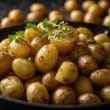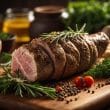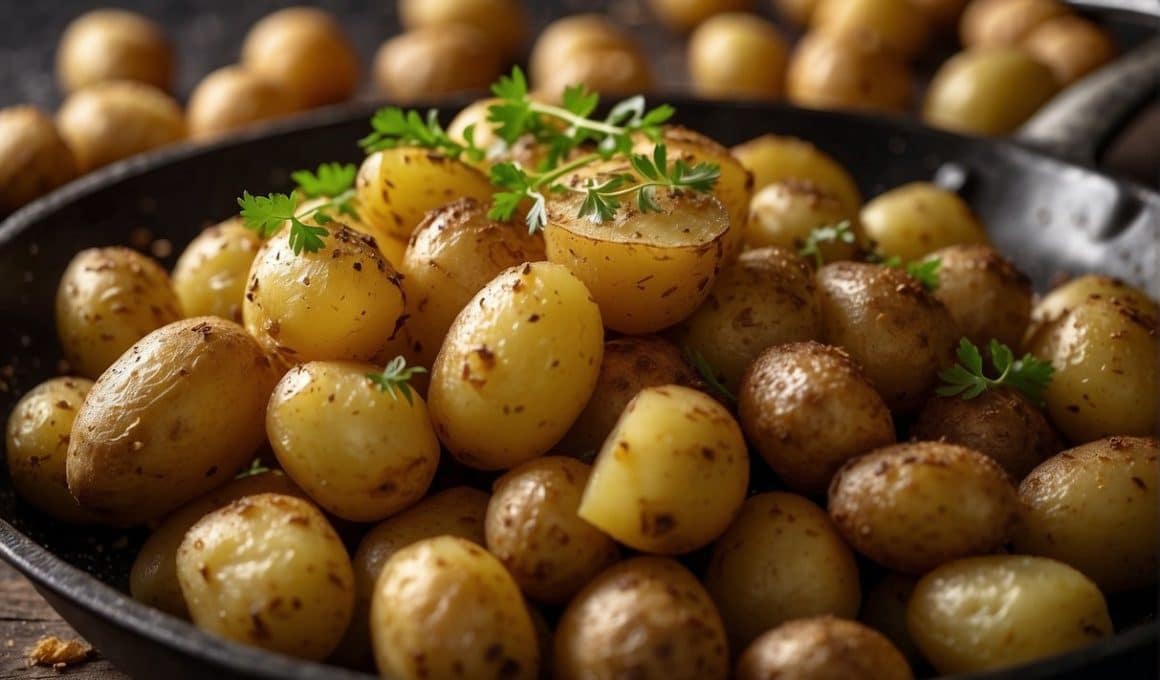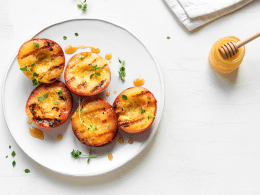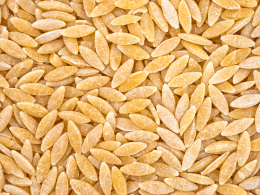Noisette potatoes, with their rich and buttery profile, have earned a respected place at the table in a variety of cuisines. The name ‘noisette’ translates to ‘hazelnut’ in French, aptly describing the small, round shape of these potatoes once they are prepared. Typically crafted using a special tool such as a melon baller, these bite-sized delights are not only attractive but also a perfect canvas for an assortment of flavors.

These golden nuggets are often sautéed to achieve a crisp outer layer while maintaining a tender interior. The art of preparing noisette potatoes requires attention to detail and timing, ensuring that each piece is well-browned and flavorful. As a versatile side dish, they can adapt to different seasonings, complementing both simple herbs and complex spice mixes. Moreover, these elegant potatoes are nutritional, providing a source of carbohydrates and dietary fiber, while their portion size makes them easy to serve.
Key Takeaways
- Noisette potatoes are appreciated for their appealing shape and versatility.
- Proper preparation and cooking techniques are essential for optimal flavor.
- They offer nutritional value and can be tailored to various seasoning preferences.
Origins and Cultural Significance

I find that the noisette potato, with its rich, earthy flavor reminiscent of hazelnuts, is a fine example of the blend between agricultural variety and culinary innovation. Its history is deeply rooted in French cuisine, a tradition renowned for its meticulous preparation and presentation of food.
French Culinary Traditions
In the realm of French cooking, the noisette potato plays a pivotal role. Its tender, buttery flesh after cooking is ideal for creating an array of dishes that emphasize the delicate balance of flavors. French chefs often use these small, round potatoes to concoct elegant side dishes, transforming simple meals into gourmet experiences. These potatoes are typically sautéed in butter to a golden brown, which further enhances their nutty taste and gives them a decadently creamy texture.
Name and Etymology
The name “noisette” itself signifies the uniqueness of this potato variety. Borrowed directly from the French word for “hazelnut,” it reflects not only the potato’s rounded shape but also its distinctive taste that sets it apart from other varieties. This linguistic tie to the hazelnut underscores the culinary value of the noisette potato and signals my appreciation for its gastronomic potential within the vast world of French cuisine.
Preparation Basics
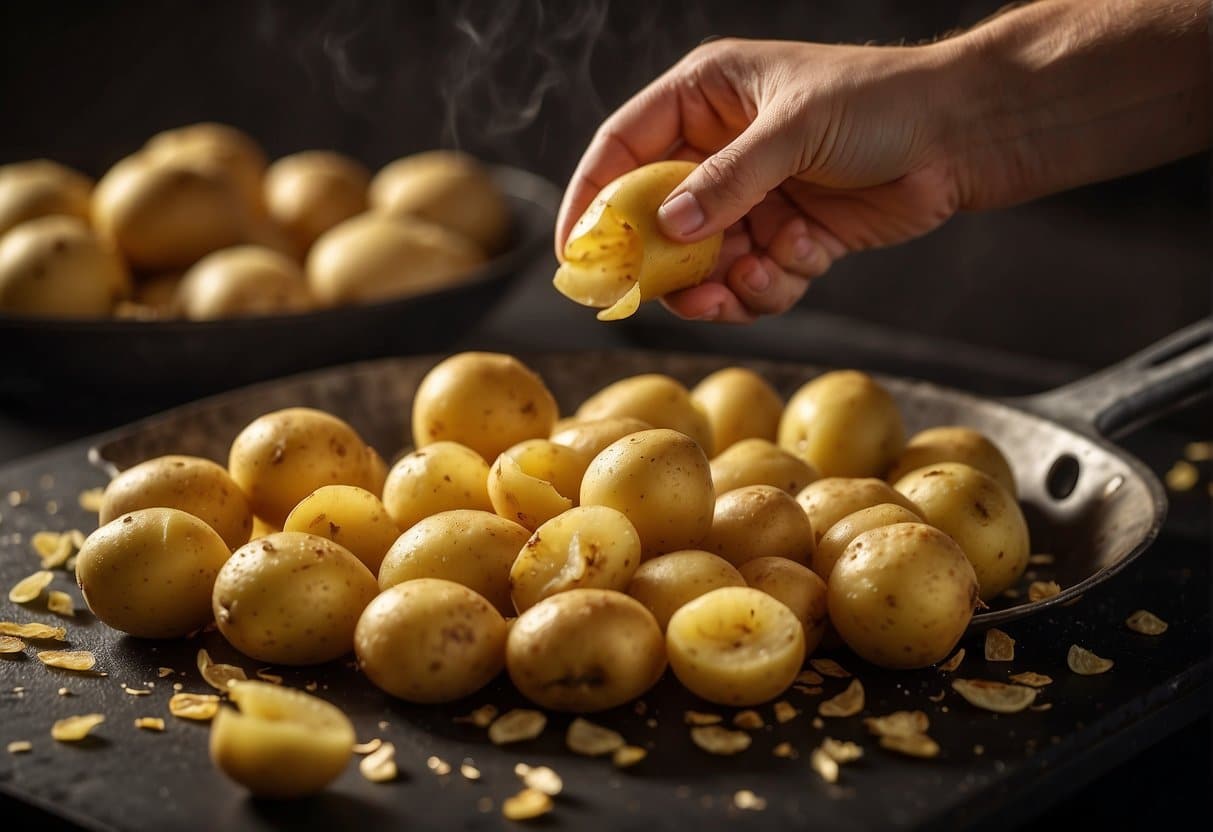
In this section, I will guide you through the foundational elements for creating noisette potatoes, ensuring we cover the critical ingredients and the necessary equipment. Let’s focus on the essentials to achieve the perfect golden texture and rich flavor.
Required Ingredients
The key to any great noisette potato recipe lies in the ingredients. I always start with high-quality:
- Potatoes: Choose a firm variety that holds its shape well when cooked.
- Salt: For seasoning the water and bringing out the potatoes’ natural flavor.
- Oil: Needed for frying to get a crisp exterior.
- Butter: Adds a rich finish and lends a lovely aroma.
Equipment Essentials
Having the right equipment on hand simplifies the process and ensures a consistent outcome:
- Melon Baller or Parisienne Scoop: To form the classic noisette shapes from the potatoes.
- Saucepan: For blanching the potato balls.
- Skillet or Frying Pan: Should be oven-safe if you’ll finish the potatoes in the oven.
- Oven: Required only if you prefer to finish cooking the potatoes in it.
First, I start with peeling and thoroughly washing the potatoes to ensure they are clean. Then, using a melon baller, I scoop out small balls of potato. These are first blanched in salted boiling water to begin the cooking process. After blanching, I pat them dry and get my skillet ready with oil to sauté the potatoes. Once they have a nice color, I add butter to the pan for that desirable flavor and if needed, I transfer the skillet to a preheated oven, where the potatoes finish cooking to a perfect texture.
The Cooking Process
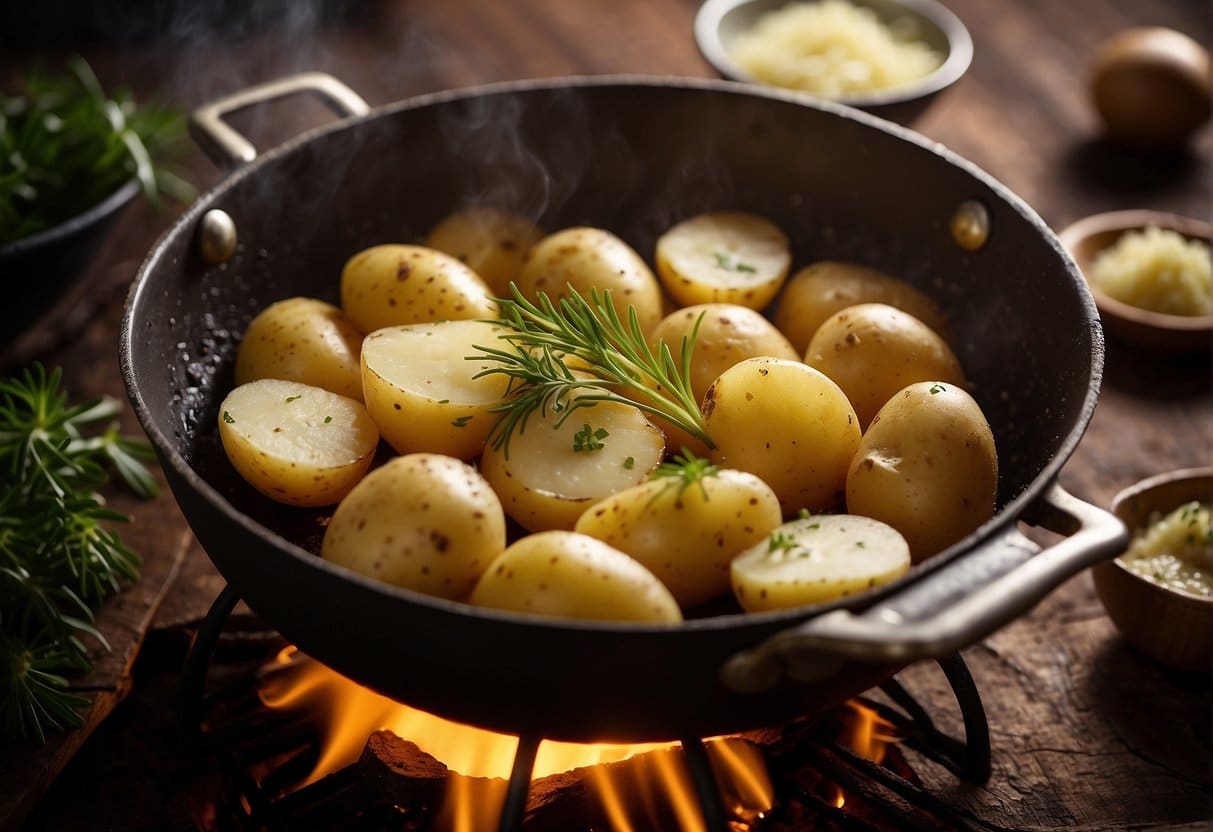
In this section, I’ll guide you through the precise steps to achieve perfectly cooked noisette potatoes. We’ll focus on forming the potato balls, boiling them to the right tenderness, and sautéing until golden brown.
Creating Potato Balls
The foundation of noisette potatoes lies in their shape. I start by selecting the right potatoes and then carefully scoop out small, hazelnut-sized balls using a noisette spoon or the small end of a melon baller. Consistency is key, so I make sure each ball is similar in size for even cooking.
Boiling Techniques
Once my potato balls are ready, I proceed to boil them. I bring a pot of salted water to a boil and carefully add the potatoes. The cook time in boiling water is usually brief, around 8-10 minutes, just enough until they are tender but still holding their shape. After boiling, I drain them and let them sit on a paper towel to remove excess moisture.
Sautéing to Perfection
Next, I heat oil in an ovenproof skillet over high heat. Then, I place the potato balls in the skillet, ensuring they’re not overcrowded to allow for even browning. The potatoes are sautéed until they reach a delicious golden brown color, requiring attentiveness to avoid overcooking. The entire sautéing process highlights the potato’s natural flavors and transforms them into a mouthwatering side dish.
Seasoning and Flavoring
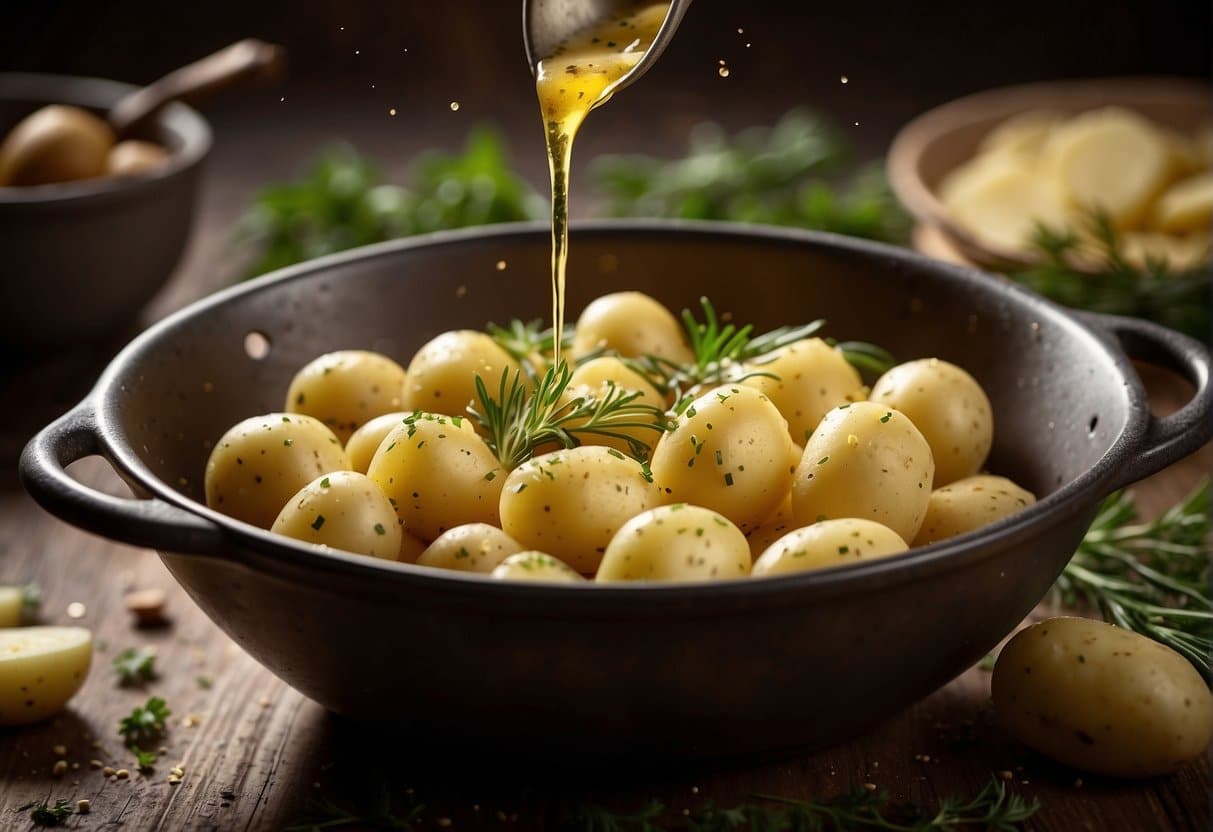
When I prepare noisette potatoes, the right blend of seasoning and flavoring can transform these spherical delights from simple to spectacular. My focus remains on enhancing their natural taste without overpowering the earthy flavor of the potatoes.
Herbs and Spices
I typically start with the essentials: salt and pepper, which work together to amplify the potatoes’ inherent flavors. From there, I explore a variety of herbs and spices. Dried parsley adds a gentle herbaceous note, while paprika provides a subtle warmth. A hint of garlic powder brings a savory depth, and onion powder contributes a mild, sweet sharpness. Together, these seasonings introduce complexity and increase the fiber content without adding cholesterol or saturated fat.
- Salt: I use it sparingly to enhance flavor without significantly increasing sodium content.
- Pepper: A robust pepper mill crack gives the perfect spicy kick.
- Parsley: It brings freshness and color without affecting protein levels.
- Paprika: This spice offers a smoky touch and antioxidants.
- Garlic Powder: It introduces a punch of flavor while keeping the dish heart-healthy.
- Onion Powder: This rounds out the taste profile and ensures the potatoes are not bland.
Balancing Flavors
Balancing flavors is key to creating well-rounded noisette potatoes. I carefully consider the flavor profile of each herb and spice to achieve a harmony that enhances taste without tilting towards any extreme. The salt is pivotal in this matter, as it sharpens other flavors present in the dish. If I find the seasoning too intense, I’ll introduce a starchy element like bread crumbs to mute overpowering notes and add a beneficial fiber boost. My priority is to maintain a balance that complements the potatoes while ensuring the nutritional content remains beneficial—with minimal saturated fats and cholesterol content appropriately managed.
Nutritional Information
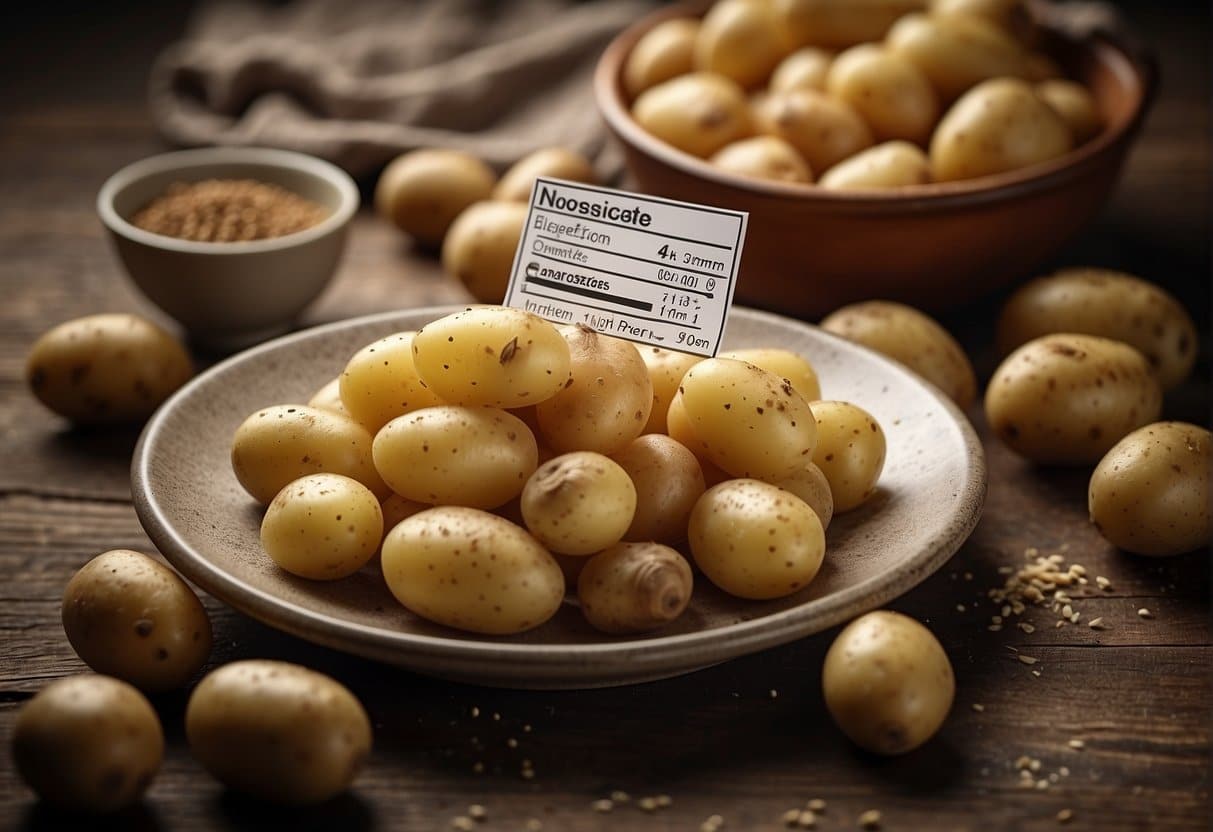
Noisette potatoes provide essential nutrients while being a delightful addition to meals. I’m here to guide you through their caloric content, health benefits, and dietary considerations.
Caloric Content
Noisette potatoes, similar to other types of potatoes, are relatively low in calories. A medium-sized, skin-on baked russet potato contains approximately 164 calories. These bite-sized morsels, once turned into noisette potatoes, may vary slightly in caloric content based on their preparation, especially if fried in oil or butter.
Health Benefits
Potatoes, including noisette, are nutrient-dense and can offer several health benefits when prepared healthily. They are high in fiber and vitamin C, with a medium potato providing about 4g of fiber and nearly half the recommended daily value of Vitamin C. Additionally, noisette potatoes are a good source of potassium, which is essential for heart health.
- Protein: An important macronutrient for muscle repair and growth, potatoes provide about 1.9g of protein per medium spud.
- Fiber: Aids in digestion and can help to maintain a healthy weight.
- Vitamin C: Essential for immune system function and skin health.
- Potassium: Key for maintaining electrolyte balance and proper nerve function.
Dietary Considerations
For individuals adhering to specific dietary guidelines:
- Vegetarian: Noisette potatoes are suitable for a vegetarian diet.
- Sodium: Naturally low in sodium, however, be mindful of added salt during cooking.
While they are low in saturated fat and cholesterol, the cooking method can significantly influence these values. If I’m frying or roasting them in oil or butter, I need to be cautious of the fat content added during the cooking process.
Serving Suggestions
I find that noisette potatoes are versatile and can be paired with a variety of dishes. Their golden, crispy exterior and tender interior make them a sumptuous addition to both casual and formal meals.
Side Dishes
- With Proteins: I recommend serving noisette potatoes alongside your favorite protein such as steak, roasted chicken, or grilled fish. They are particularly delightful with beef tenderloin, complementing its richness without overpowering its flavor.
- In Salads: Toss them into a green salad for an unexpected twist. The muted flavor of potato pairs well with a sharp vinaigrette and fresh, leafy greens.
- With Vegetables: Combine roasted or steamed vegetables like asparagus or green beans with these potatoes for a balanced meal.
Presentation Tips
- Plating with Garnish: I often use fresh herbs like parsley or rosemary to garnish plated noisette potatoes which adds a pop of color and a hint of freshness.
- Creative Arrangements: For a more elegant presentation, I arrange the noisette potatoes symmetrically around the main dish. This showcases the potatoes and makes the entire plate more visually appealing.
- Accompanying Soups: When serving soup, I sometimes place a few noisette potatoes on top as an edible garnish. This adds a satisfying crunch that complements creamy soups beautifully.
Advanced Techniques
In my culinary experience, mastering advanced techniques for noisette potatoes can take this classic dish from good to exceptional. It’s all about precision in preparation and understanding the benefits of different cooking methods.
Variations
Variations in the preparation of noisette potatoes begin with the selection of the potato. I recommend using firm varieties that hold their shape well when cooked. Before cooking, I ensure the potatoes are cut into even hazelnut-sized balls, which promotes uniform cooking and a visually appealing finish. Sometimes, I infuse the frying oil with aromatic herbs or garlic to add a subtle yet distinctive flavor to the potatoes.
Finishing in the Oven
To achieve a golden and evenly cooked exterior, I start by sautéing the potato noisettes in a hot frying pan until they develop a lightly crisp outside. Then, I preheat the oven to 350°F to finish cooking in the oven. This method allows for a gentle and thorough roasting, creating a delicate soft interior. Here’s my process:
- Preheat oven to 350°F.
- Sauté potatoes over medium-high heat until golden.
- Without stirring, transfer the frying pan to the oven.
- Roast the potatoes until fork-tender, approximately 30-40 minutes.
This combined technique of starting the noisette potatoes on the stovetop and finishing them in the oven ensures a beautifully roasted product that’s crispy on the outside and tender on the inside.
Food Waste Minimization
When it comes to managing noisette potatoes, I’m meticulous about minimizing waste. It’s disheartening to acknowledge that much of the food produced ends up as waste. In the US alone, a staggering amount of food is thrown away, and produce like noisette potatoes are part of this statistic.
I start by purchasing only the amount I need, aiming to prevent surplus that might spoil. When storing them, I ensure they’re kept in a cool, dark place to extend their shelf life. Here’s a breakdown of how I incorporate these practices:
- Buying Habits: I buy in quantities that I can consume, opting for smaller batches more frequently if necessary.
- Proper Storage: I keep my potatoes in a breathable container, away from onions to prevent spoilage.
In my kitchen, creativity is key to using potatoes in their entirety:
- Peels: I clean them thoroughly and bake them to make crispy potato skins.
- Eyes and Sprouts: I remove these parts but use the rest of the potato without hesitation.
Cooking methods also play a role in reducing waste. For instance, I opt for recipes that utilize the entire potato, such as mashed or roasted noisette potatoes. If there are leftovers, I incorporate them into a new meal, perhaps a potato hash or soup the following day.
By being conscious about my consumption and using innovative techniques to utilize my produce fully, I contribute to a larger cause: reducing food waste. Every small action counts, and by taking such steps, I help create a more sustainable kitchen and planet.
Tools and Gadgets
When I set out to make noisette potatoes, having the right equipment at my disposal is crucial to achieve that desirable golden crust and tender interior. The utensils aren’t just for efficiency; they contribute to the final shape and texture of the potatoes.
Specialized Utensils
Noisette Spoon: My go-to tool for creating the classic noisette potato shape is a noisette spoon, also known as a melon baller. It’s designed to scoop out small, rounded portions of potato, resembling the size of a hazelnut. The key is to press the spoon firmly into the potato and twist it to carve out a smooth, rounded ball. For information on how to properly use the spoon and the technique required, I refer to Eatwell101’s guide on making Potato Balls.
Parisian Spoon: Similar to the noisette spoon, a Parisian spoon also helps in shaping the potatoes. However, it’s often confused with a melon baller. The main difference I’ve found is in the size and sharpness of the edges, which can affect the shape of the potato balls.
Skillet: Once my noisette potatoes are shaped, I use an ovenproof skillet to sauté them. It’s important that the skillet is ovenproof because after browning one side on the stove, I transfer the skillet to the oven to roast the potatoes until they’re fork-tender. A high-quality skillet ensures even heat distribution for a perfect golden-brown crust. A Cuisine at Home recipe outlines the process, emphasizing the importance of an ovenproof skillet in the cooking of Noisette Potatoes.
By employing these tools, I ensure that my noisette potatoes are not only delicious but also aesthetically pleasing, with a consistent size and shape.
Recipe Development
As I refine my noisette potatoes recipe, it’s essential to focus on the textures and cooking times that can affect the final dish’s quality and appeal.
Experimenting with Textures
I’ve discovered that texture is a pivotal component in the success of a noisette potatoes recipe. My approach involves different preparations of potatoes to achieve the perfect balance between a crispy exterior and a fluffy interior. For instance, I found that using a melon baller to shape the potatoes ensures uniformity, which is crucial for even cooking. I first boil the potatoes until they are tender, which typically takes about 8-10 minutes.
Adjusting Cooking Times
The cooking times are as critical as the texture. In perfecting this recipe, I have adjusted the sautéing and roasting times to ensure the potatoes are well-browned and fork-tender. Adequate time in the oven, at 350°F for about 30-40 minutes, allows the starch within the potatoes to develop a rich flavor and a desirable texture. When returning them to the stove top, I stir in melted butter for that final glossy, flavorful coat.
Through this process, I’ve created content, including videos, that clearly demonstrates the steps involved, providing viewers with a comprehensive guide to replicate the noisette potatoes recipe in their kitchens. My focus is to be accurate with measurements and times to avoid common pitfalls such as undercooked centers or overly crispy skins that detract from the balanced texture that a good noisette potato should have.
User Engagement
In my experience, effectively engaging users on digital platforms can significantly enhance the visibility and popularity of content. This section focuses on how I share noisette potatoes recipes on various platforms to foster community interaction and growth.
Sharing on Platforms
When I share my noisette potatoes recipes online, I prioritize platforms where food enthusiasts congregate. Here’s my strategy:
- Identify the Right Category: I ensure that my content is listed under the correct food and recipe categories to reach the right audience.
- Engage with Followers: I actively respond to comments and questions to build a community around my content.
- Be Independent and Authentic: My recipe creations are unique, which encourages followers to see my website as a go-to source for noisette potatoes.
- Encourage Questions: By inviting followers to ask questions, I demonstrate my expertise and willingness to offer guidance.
- Contact Information: I provide clear contact information for inquiries related to careers, partnerships, or general information.
- Track Engagement: I monitor which posts perform well to refine my sharing strategy continuously.
Through this approach, I aim to connect with individuals across the web who share a passion for culinary creativity, particularly with this versatile dish.
After Cooking Care
After preparing noisette potatoes, it’s essential to manage them correctly post-cooking to maintain their quality. I’ll share the best practices for storing and reheating these delicate morsels to ensure they remain enjoyable for later consumption.
Storage and Reheating
Storage:
To store noisette potatoes, allow them to cool to room temperature. Then, transfer them to an airtight container and refrigerate. This process will help preserve their texture and flavor for up to three days.
- Do Not:
- Leave them at room temperature for over two hours.
- Use non-airtight containers that may cause the potatoes to absorb odors.
Reheating:
When reheating noisette potatoes, aim to restore their crispness while maintaining their tender insides. My preferred method is to use the oven or a toaster oven.
- Preheat the oven to 350°F (175°C).
- Spread the potatoes in a single layer on a baking sheet.
- Heat for 5–10 minutes or until they’re heated through and crisp.
Tip: To prevent drying out, cover the potatoes lightly with foil while reheating in the oven.
Follow These Steps to Avoid Sogginess:
- Do not microwave, as it can make the potatoes soggy.
- Reheat only the amount you’ll eat to avoid multiple reheating sessions.
- If the potatoes were frozen, thaw in the fridge overnight before reheating.
Frequently Asked Questions
In this section, I’ll address some of the most common inquiries about noisette potatoes to help clarify your understanding and enable you to enjoy this delightful dish.
How can I make noisette potatoes at home?
To make noisette potatoes at home, I usually start by peeling my potatoes and then using a melon baller to create small, hazelnut-sized spheres. After boiling them briefly, I sauté the potato balls in butter until golden brown. There’s an easy-to-follow recipe that walks through the whole process at Marie Food Tips.
Where can I find a store that sells noisette potatoes?
Noisette potatoes can sometimes be tricky to find, but I suggest checking local gourmet grocery stores or specialty food markets. If you prefer ready-made options, some supermarkets may carry them alongside other specialty potato products.
Are there any brands that sell frozen noisette potatoes?
Yes, there are brands that offer frozen noisette potatoes for those looking for convenience. These are typically found in the frozen foods section of grocery stores. I find these a great time-saver and they can be a healthy option compared to other frozen potato products.
What is the correct pronunciation of ‘noisette’ when referring to potatoes?
The word ‘noisette’ when referring to potatoes is pronounced as [nwah-zett]. It’s a French term that translates to ‘hazelnut’, which describes the small, round shape of these potatoes.
What are the ingredients in classic noisette potatoes?
Classic noisette potatoes typically require only a few ingredients: potatoes, butter, and salt. If you want to make them a little richer, some recipes might call for a dash of oil or herbs for additional flavor.
Can you explain the term ‘pomme noisette’ and its culinary usage?
‘Pomme noisette’, or noisette potatoes, refers to small, ball-shaped potatoes that are typically sautéed until golden. The name derives from their resemblance to hazelnuts (‘noisette’ in French). In culinary usage, ‘pomme noisette’ often refers to a side dish that adds an elegant touch to a variety of meals.


